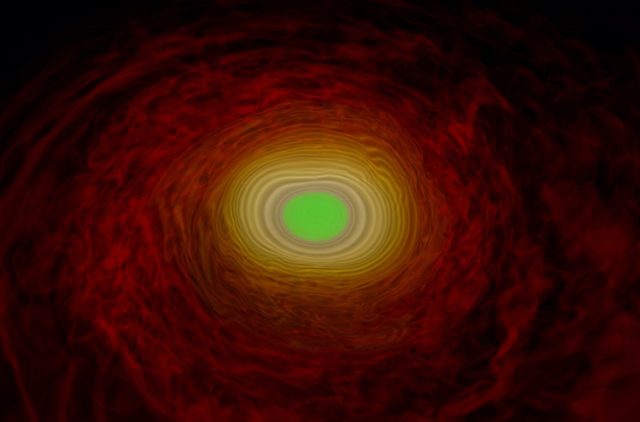Going with the cosmic flow –
Simulations show that QGP could form in immediate aftermath of neutron star merger
“Compared to previous simulations, we have discovered a new signature in the gravitational waves that is significantly clearer to detect,” said co-author Luciano Rezzolla of Goethe University in Frankfurt, Germany. “If this signature occurs in the gravitational waves that we will receive from future neutron-star mergers, we would have a clear evidence for the creation of quark-gluon plasma in the present universe.”
A hot, dense soup
Quarks, the fundamental components of subatomic particles, are bound together by force-carrying gluons to form protons and neutrons. But under the extreme high-energy conditions of the early universe in its first microseconds of existence, that couldn’t happen. Instead, quarks and gluons mingled freely in a dense soup, until things cooled down sufficiently for protons to condense out of the QGP. Before the first second was up, the Universe had gone through its entire inflationary period, sowing the seeds for the large-scale structures we see today.
To create QGPs in the lab — at Brookhaven National Laboratory’s Relativistic Heavy Ion Collider (RHIC) and at the Large Hadron Collider at CERN — physicists must achieve temperatures hundreds of thousands of times hotter than the sun. They do so via heavy-ion collisions (using gold at RHIC, lead at the LHC) to generate the enormously high energies required to blast the nucleon apart. As Ars’ John Timmer explained in : The quarks and gluons that spill out of a proton collision tend to have nothing but empty space around them. In a heavy ion collision, the large number of nucleons that are broken apart at once means that, instead of flying into empty space, a given quark or gluon will have the opportunity to interact with those pouring out of nearby nucleons. As a result, for a brief instant, the collisions don’t look much like an explosion; Instead, it looks more like the boundaries between nucleons melting, leaving behind a sea of quarks and gluons that are interacting.
Physicists were surprised to (discover in That the QGP isn’t really a gaseous plasma in terms of its behavior. It’s more akin to a superfluid, since there is virtually no viscosity (resistance from friction) —it is, in fact, the most perfect liquid yet observed. Later experiments revealed that particle collisions within the QGP swirl faster (a measure of vorticity) than any other known fluid, too.
Lukas R. Weih & L. Rezzolla (GUF) / CERN
A telltale signature?
Where might we find a QGP in the universe today? Rezzolla and his GUF colleagues thought a binary neutron star merger might be a good candidate, and they hypothesized that we could find evidence for a QGP in the gravitational waves produced by such a merger, thanks to the continued success of LIGO.
LIGO detects gravitational waves via laser interferometry, using high-powered lasers to measure tiny changes in the distance between two objects positioned kilometers apart. A third detector came online at VIRGO in .)) Each instrument is so sensitive that it also picks up small ambient vibrations, like a rumbling freight train or natural thermal vibrations in the detectors themselves.
 Enlarge / In the immediate aftermath of a binary neutron star merger, a QGP can form.
Enlarge / In the immediate aftermath of a binary neutron star merger, a QGP can form.
Lukas R. Weihh & Luciano Rezzola / GUF
There have been a number of additional gravitational wave detections since then, most notably (s) binary neutron star merger
, supported by a simultaneous gamma-ray burst and signals in the rest of the electromagnetic spectrum. And last year LIGO / VIRGO observed five gravitational wave events in a single month. Three were from merging black holes, one was the second neutron star merger, and another may have been the first instance of a neutron star-black hole merger. So the likelihood of detecting additional binary neutron star mergers in the future is strong./ PhysRevLett. 550. (
) (About DOIs) ).(Listing image by Lukas R. Weih & L. Rezzolla (GUF) / CERN
(Read More)
full coverage and live updates on the Coronavirus (Covid – 124)





GIPHY App Key not set. Please check settings